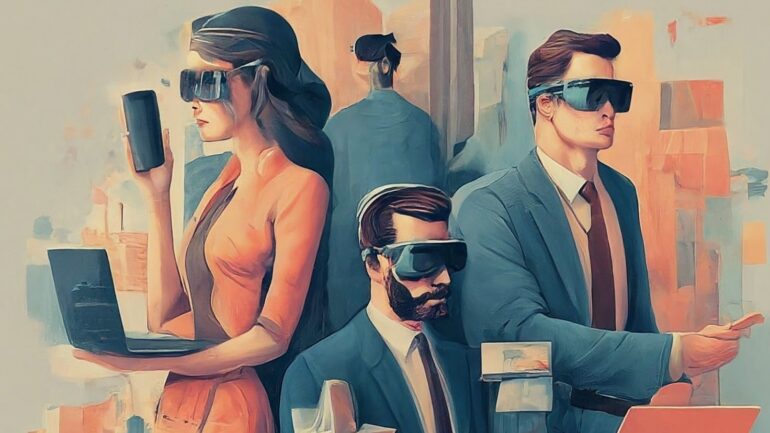Beyond the Rectangle: Why Smart Glasses Are Poised to Eclipse Mobiles, TVs & Even Laptops

A trifecta of forces—technology, economics, and use-case maturity—are transforming smart-glasses from an oddity to a challenger to phones and notebooks.
The due of omnipresent screens in our lives – the mobile and the television – is about to be made redundant. In the not-too-distant future our primary window on the digital world may no longer be a block of glass in the hand, a rectangle on the wall, or even a clamshell on the table, but the lenses resting on the bridge of our nose. A trifecta of forces—technology, economics, and use-case maturity—are transforming smart-glasses from an oddity to a challenger to phones and notebooks. The age of face-first interfaces is arriving faster—and more quietly—than most rectangular screens will notice.
It is forecast that screens will come even closer to (or on) our faces, such as mixed reality headsets that fuse the real world around you with digital information superimposed on top of your view. Rather than rely on a phone in our hand — for information, communication, navigation, and entertainment — what if technology seamlessly blended into our bodies and clothing? The other school of thought is fewer screens, maybe with smaller wearable devices, à la Internet of Things (IoT), and an “ambient computing” approach in which technology seamlessly (and somewhat invisibly) integrates into our daily lives, allowing us to return to being present. Products incorporating some of these technologies have already started to hit the market.
Samsung showcased its first AR head-mounted device based on the Android XR platform—Project Moohan as recently as on March 3, at the Mobile World Congress 2025 in Barcelona, Spain. This product is co-developed by Samsung, Google, and Qualcomm. The headset sports a look reminiscent of ski goggles, similar to Apple’s Vision Pro. Meta Platforms is expanding access to its artificial intelligence assistant, Meta AI, on Ray-Ban smart glasses to seven additional European countries.
Huawei has once again pushed the boundaries of wearable technology with its latest innovation. It has unveiled the Eyewear 2 Titanium Edition, elegant frames and optical lenses that blend fashion with cutting-edge functionality. This smat eyewear is a major evolution in how we integrate technology into our daily accessories. Like a conductor’s baton directing an orchestra, simple head movements allow users to control various functions. Nodding answers calls, while a head shake rejects them – creating an intuitive interface that feels natural rather than technical. This hands-free approach represents a significant step forward in technology integration in stylish wearables.
Fortune Business Insights: Estimated the VR market at US$32.40 billion in 2025, with a CAGR of 42.05% through 2030, by then it could add USD 450.5 billion to the global economy. Advances in AI have driven major enhancements to AR and VR technology, improving rendering, tracking and processing. This has made an especially big difference in gaming, in the realism of 3D characters and environments, and the dynamic possibilities of game scenarios and interactivity.
DHL, the world’s leading logistics company, has successfully carried out a pilot project testing smart glasses and augmented reality in a warehouse in the Netherlands. In cooperation with DHL customer Ricoh and wearable computing solutions expert Ubimax, the technology was used to implement ‘vision picking’ in warehousing operations. Staff was guided through the warehouse by graphics displayed on the smart glass to speed up the picking process and reduce errors. The pilot proved that augmented reality offers added value to logistics and resulted in a 25 percent efficiency increase during the picking process.
Twenty-four years ago, the surgeon Santiago Horgan performed the first robotically assisted gastric-bypass surgery in the world, a major medical breakthrough. Now Horgan is working with a new tool that he argues could be even more transformative in operating rooms: the Apple Vision Pro. Over the last month, Horgan and other surgeons at the University of California, San Diego have performed more than 20 minimally invasive operations while wearing Apple’s mixed-reality headsets.
What could possibly replace even the ubiquitous TV? According to current industry observations, it’s not a bigger screen, nor a more advanced version of the same technology. Instead, the replacement might be screens that don’t physically exist at all. This is where virtual screens come into play. Enabled through smart glasses or head-mounted displays, these screens are rendered in a user’s field of view rather than mounted on a wall.
Devices like the recently released Apple Vision Pro, introduced in early 2024, are leading this new direction in consumer tech. These headsets allow users to watch content from anywhere in their home — without needing a single physical display.One of the main draws of virtual screens is their mobility. With headsets like Apple’s, users can fix their virtual displays in one part of a room or take them along as they move through the house. This offers a unique advantage over traditional TVs, which are inherently stationary.
While Alexa-powered frames have been around for a while, the just-launched Lucyd Lyte eyewear (from $149) is billed as the first to incorporate OpenAI’s generative AI darling, ChatGPT. Rather than typing long queries at a PC, you can simply click the touch button on Lucyd Lyte eyewear and speak your query and hear the response instantly. According to the makers of this gadget, there are several practical features enabled by Lucyd’s ChatGPT eyewear, including instant help translating English into a variety of other languages, solving complex equations and other educational information on almost any topic, and “gaining useful insight and advice for a near-infinite number of situations [including] detailed help with repairs, cooking, writing, and many other activities.
Nevertheless, despite their futuristic appeal, virtual screens are not without drawbacks. Two significant barriers stand in the way of widespread replacement of televisions. First is the physical burden. Wearing a headset for long periods can be uncomfortable, and prolonged use may lead to headaches or fatigue. Unlike sitting back to passively watch a show, this new format demands a degree of physical endurance from the user.
And, these devices are inherently individualistic. While a TV invites shared viewing experiences, a headset creates a solitary one. Watching a movie on a mixed reality headset isolates the user, making group entertainment virtually impossible — unless everyone owns and uses a similar device. The TV has been a social innovation when we gathered together to watch a sporting event to share the excitement, but headsets could mean the end of watching a nail-biting cricket match with a group of friends a thing of the past.


